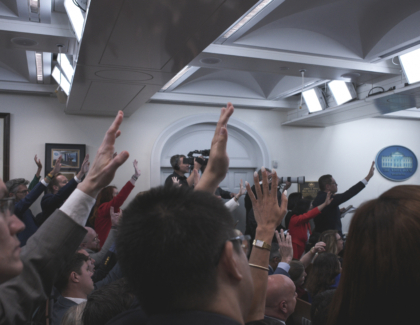Sign up for the daily CJR newsletter.
A report released Wednesday by the Washington Post Newspaper Guild shows that the Post is struggling to retain Black employees. The union’s study on pay, diversity, and retention—which covers 2016 to mid-2021 and includes non-newsroom staff—shows that Black employees and people of color are leaving the company at disproportionately high rates: in 2020, more than one in three Guild-eligible journalists who left the newsroom were Black, despite Black journalists’ making up just 9.2 percent of newsroom employees that year.
The Post did hire more journalists of color in recent years: while in 2017 just 17 percent of new hires were people of color, in 2020 and the first half of 2021, 52 percent of new hires were people of color. But in the same period, 45 percent of those who left the newsroom were people of color, even though they made up just 22 percent of the newsroom. And fewer than one in five of those hired in 2020 were Black.
A companion report by the Guild’s Black Caucus, drawing on interviews with more than thirty current and former employees, describes how Black journalists were underpaid, devalued in their work, stymied in their career growth, and faced with indifference or hostility in pushing for better coverage of communities of color and for diversity in the company.
Many of those who left were Black women, and Post employees say the steady drumbeat of departure announcements was demoralizing or painful. “The people who fought the hardest to push the Post to evolve are the ones who had to leave, ultimately, because it is such an exhausting job,” Simone Sebastian, who was the Post’s America editor until November, told me. “And I wish that there was more awareness at the Post, and at newspapers across this country, that Black people who are pushing them to do better are valuable.” (Sebastian, who says racial struggles at the Post were not a large factor in her own decision to leave, is now editorial director at Capital B, a Black-led nonprofit news organization.)
The Guild acknowledged that the Post has made some progress in recent years. But the report makes clear that the Post cannot address its lack of diversity and equity simply by hiring more people of color, without addressing the underlying systems perpetuating those inequalities.
The message of the Black Caucus report is not that the company is irredeemable, Michael Brice-Saddler, a Post reporter who is also vice chair for news in the Guild and founder of the Guild’s Black Caucus, told me. But many feel they haven’t been heard, and hope this report will change that. “This is a group of dozens of Black staffers who care tremendously about this place, and believe it can be better,” he said. “Where we’re coming from is wanting the Post to be a place where Black staffers can feel like they can grow and have a career that lasts a really long time.”
Kristine Coratti Kelly, a spokesperson for the Post, wrote in an email, “We have long been committed to paying employees fairly, taking into account all relevant factors, and we have spent the last five years refining our data-driven approach to pay. We have also put systems and processes in place over the last two years to not just grow diversity at The Post, but ensure we are fostering an equitable and inclusive workplace. We appreciate The Guild pointing out the progress we’ve made, and it remains an important priority.”
The period covered in the Guild report saw rapid growth and change at the Post. The company expanded its newsroom by nearly 50 percent. In 2020, as protests over racial injustice and white supremacy swept the nation, more than five hundred Post staffers signed a letter calling for changes at the paper. In response, the paper created a managing editor position for diversity and inclusion, added newsroom positions focused on covering race and identity, and started programs meant to encourage internal career growth. The company also added a human resources director for diversity and inclusion. Last year, Sally Buzbee became the Post’s first female executive editor, and she expanded the masthead to include more women and Black journalists.
The study shows that while pay gaps in the newsroom have narrowed since the Guild’s last pay study, in 2019, white journalists continue to earn more than journalists of color, with a disparity of nearly 16 percent between median salaries. The gap between median salaries of white men and women of color was more than 28 percent, or nearly $29,000. And salaried men still make more than women, while women who are paid hourly make more than men.
The gender pay disparity is greatest in employees under the age of forty, where there was a gap of 14 percent, or about $13,000. This is partly explained by the fact that white men have the oldest median age of the newsroom, while women of color have the youngest. But even controlling for age, disparities obtained. Sections with the highest median salaries, like national, investigations, and opinion, have a higher concentration of white men, while the sections with lower median salaries have a larger representation of women and people of color.
But the report also shows that the Post appears to be perpetuating pay disparities with its merit raise system. The highest scores on performance reviews, according to the study, are disproportionately given to white employees. In the period covered by the report, white people received 76 percent of merit raises despite making up 67 percent of the newsroom. Since 2015, men have also received a higher percentage of merit raises than women, though they make up a smaller percentage of the newsroom.
While Post employees can request a salary review to establish whether they are underpaid relative to their peers, it does not guarantee that the company will address any disparities. The report describes a journalist in the video department who underwent a pay review in 2020 that confirmed her suspicion that she was “grossly” underpaid. But “no resolution was offered,” even after she received a positive performance review. The report says the journalist is now looking for another job, despite wanting to stay at the Post.
The Black Caucus report suggests that many Black journalists left the Post not because they wanted to, but because they found that was the only way they could grow their careers, be paid at market value, or find respect for their work.
Black employees described being overlooked for merit raises and promotions despite outperforming their colleagues; having the legitimacy of their work consistently challenged; and being asked to take on menial tasks outside their roles, unlike their white colleagues. Some described being stuck in undesirable shifts, and their ideas and work being given to white colleagues. They were also expected to deal with regular microaggressions, and felt discouraged by the dearth of Black leadership.
The lack of upward mobility was a complaint across the newsroom but was especially prevalent among those in digital-focused roles and among Black employees. Since 2020, the audience department—one of the most diverse at the Post—has lost at least ten employees to competing news organizations, more than half of them women or people of color. Six of those who left were managers, all but one of whom were women or people of color.
The report makes clear that the Post cannot address its lack of diversity and equity simply by hiring more people of color, without addressing the underlying systems perpetuating those inequalities.
The report also described the video department as troubled: since 2020, four out of eleven Black employees left the section. A Black woman who worked in the video department said in the report that people of color warned her against taking the video job because “her life would be miserable.” It added that “she agreed with this assessment afterward, adding that conditions were ‘also at times [verbally] abusive.’”
The report describes how Black journalists feel a duty to “step up and advocate coverage of stories about Black people that the rest of the newsroom has historically overlooked or underreported.” But this often leads to burnout, not only because of the workload, but also because editors and colleagues “are often ill-equipped to support us as we do the work.”
The extra labor Black reporters take on to push for change and advocate for better coverage of communities of color is not often acknowledged or rewarded, Razzan Nakhlawi, a Post researcher, Guild communications chair, and member of the Guild’s Black Caucus, told me. She says it was affirming to find in the report that Black employees share similar experiences, and to see those experiences reflected in the data. “Fundamentally we’re experiencing a lot of the same things, and we don’t necessarily talk openly about this stuff.”
In 2020, a former editor wrote to the masthead “asking newsroom leaders about the boundaries around what Black journalists at the Post were allowed to say publicly about police brutality and systemic racism,” according to the report. In response, a managing editor called her and told her to “consider whether journalism is for [her].” She left for a leadership role at a legacy publication.
Overall, despite its efforts, the Post has not substantially increased the diversity of its workforce. In mid-2021, 56.3 percent of employees across the entire company—including its business side—were white, down slightly from the 2016 level of 57.6 percent. Among leadership, it was even whiter: 66.5 percent in 2021, down 1.7 percentage points from 2016.
While most racial or ethnic groups saw their representation grow slightly in the company during this period, there was a stark decline for Black employees. Across the company as a whole, Black employees went from 25 percent of the workforce in 2016 to 18.8 percent in 2021, and their share in leadership positions fell to 15.9 percent from 20 percent. Among Guild-covered workers on the commercial side, the share of Black employees fell to 25.5 percent in 2021 from 33.8 percent. (The share of Black journalists in the newsroom fell by about one percentage point, to 9.4 percent.)
In August 2020, a group of workers on the commercial side, where the report shows the pay disparity between white employees and employees of color grew since 2019 to a median gap of $17,600, wrote a letter to Fred Ryan, the Post’s publisher, describing “instances of racism, discrimination and inequality in their departments.”
The report includes an excerpt from the letter: “Did you know that in the Accounting and Finance departments of the Washington Post, the commercial side of the organization is referred to as ‘The Plantation,’ because many of the workers are Black and being overseen by White bosses? Highly educated Black employees continue to be stuck in roles on ‘The Plantation’ for years with no hope of climbing up the ladder, while White employees are promoted into unadvertised positions unrelated to their current jobs.”
The letter highlighted “the profound distrust Black employees have in Human Resources—so much so that they asked the publisher to move the new diversity and inclusion director position outside of HR entirely.” According to the report, commercial employees say HR has “prioritized self-protection over protecting employees and managers who experienced systemic discrimination or racism, failing to hold their own to the same standard they demand of other staffers. And unlike the newsroom, where managing editors operate as liaisons between HR on personnel matters, commercial employees have no such buffer and are left to fend for themselves.” Instead of responding to the letter, says the report, Ryan forwarded it to the Post’s director of HR.
David DeJesus, cochair of the Guild for commercial, says that made employees feel like “we’d been kicked to the curb.” He says he hopes the company will view the report as an opportunity to effect real change. “We just want to make our workplace a better place.”
The report details recommendations for the Post. “A great start would be being willing to engage on this, acknowledge that some people are hurting or have been hurt, and then saying, ‘Where can we go from here? And what do we need to do to make things right?’” Brice-Saddler says. “And I think that type of acknowledgment will go a long way.”
Some Post staffers are hopeful, given the recent change in leadership, that the company may work to address the issues raised in the report. And Guild members say they are ready to work with the company on doing so. “It feels like this could be a great opportunity,” Nakhlawi says. “And we invite the company to view this as such. I hope that it’s taken seriously.”
This article has been updated to include comment from the Washington Post.
Has America ever needed a media defender more than now? Help us by joining CJR today.







